One of Canada’s greatest, yet least known, military achievements
There was a wreath laying ceremony today (Friday 22) at the Canadian War Museum in Ottawa, the national capital.
The Honourable Kent Hehr, Minister of Veterans Affairs and Associate Minister of National Defence, addressed Canada’s Korean War Veterans to commemorate the 65th anniversary of the Battle of Kapyong.
As they had so often in the two previous World Wars, outnumbered Canadian troops once again held their ground against a larger enemy force, this time on a remote strategic hilltop in Korea.
Some 40 kilometres north of the Republic of Korea capital, Seoul, and within sight of the town of Kap’yong are a series of steep mountainous ridges known by UN forces as Hill 677 and another high point about 5 km across the valley known as Hill 504. They are situated about 20km behind what had been the 1951 front line against Chinese and North Korean communist forces.
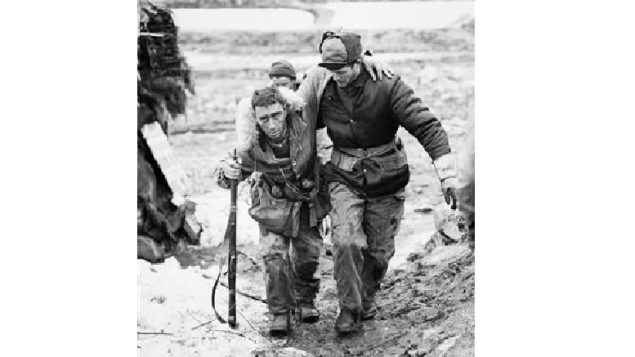
2PPCLI Private Morris J. Piche being helped to an aid stantion by LCpl W.J. Chrysler/Kapyong Valley, during 27th Brigade advance, early 1951 (Imperial War Museum -MH033026)
The 700 Canadians then in reserve, would soon face a determined Chinese force of between 5,000 to 7,000 soldiers..
On April 22 the Communist Chinese forces began a major offensive along the entire United Nations front, but with a concentrated force heading towards the Kap’yong valley and a direct route towards Seoul, the major objective.
American forces, the US 1 and IX Corps under heavy fire were forced to withdraw from the front leaving two RoK regiments to block the Communist drive.
By the 23rd, the front was collapsing and Canadians were moved from the reserve to occupy the strategic Hill 677, with Australians on Hill 504, both of which overlooked the valley route through the mountains toward Seoul.
Hastily building defensive positions, they were shocked to see streams of Korean forces and vehicles in full disorganized retreat rushing through the valley.
(from Korea Vets Assoc. website) Capt. Owen R. Browne, officer commanding Able Company, later wrote in a regimental journal:
“It was then, about mid-afternoon (April 23), that the rumour of the collapsing front acquired a meaning. From my arrival until then both the main Kap’yong Valley and the subsidiary valley cutting across the front had been empty of people. Then, suddenly, down the road through the subsidiary valley came hordes of men, running, walking, interspersed with military vehicles — totally disorganized mobs. They were elements of the 6th ROK Division which were supposed to be ten miles forward engaging the Chinese. But they were not engaging the Chinese. They were fleeing! I was witnessing a rout. The valley was filled with men. Some left the road and fled over the forward edges of “A” Company positions. Some killed themselves on the various booby traps we had laid, and that component of my defensive layout became worthless . . . between 1530 hours and 1800 hours all of A” Coy speeded up its defence preparations and digging as it watched, helpless to intervene, while approximately 4000-5000 troops fled in disorganized panic across and through the forward edges of our positions. But we knew then that we were no longer 10-12 miles behind the line; we were the front line.”
Chinese forces had infiltrated the retreating Koreans and immediately launched an offensive against the Australians who held out throughout the 23rd and into he 24th, but suffering 155 casualties and running out of ammunition and supplies, they were forced to withdraw.
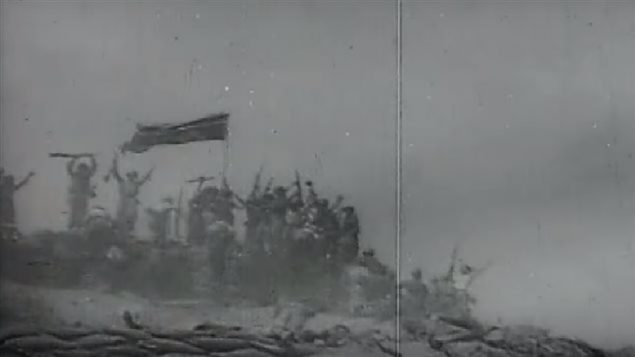
Communist troops atop Hill-504 after Australian withdrawal. Now occupying a high point, the Communists could now concentrate their forces on eliminating the Canadians just across the valley on Hill-677 (Test of Will-Canada in Korea- YouTube)
The Chinese then turned to concentrate on the 2nd Battalion Princess Patricia’s Canadian Light Infantry atop Hill-677, now cut off and alone.
The attacks began that night and continued relentlessy into the 25th. Wave after wave of Chinese attackers with mortars, grenades and machine gun fire tried to push the Canadians off the hill, but were repulsed each time with heavy losses.
The defenders desperately hung on, and with fixed bayonets in many cases had to engage in hand-to-hand combat as the Chinese tried to overrun the Canadian positions. Throughout the night, individual acts of heroism were many.
Pte. Ken Barwise, single-handedly recaptured a Vickers machine gun taking down many of the attackers. Pte Wayne Mitchell, wounded twice and weak from loss of blood, continued to fire his Bren with effect. Ken Campbell, D-company commander was hit five times as the Chinese tried to overrun his position, three in the shoulder, one in the lining of his heart, and another collapsing a lung. He survived.

After repeated attacks on the various defensive positions and battalion headquarters, the Canadians were running low on ammunition. With the Chinese actually within their positions in some cases, the Canadians had no choice but make a desperate call for artillery fire onto their own position. New Zealand gunners further back in the valley poured down hundreds of shells onto the Canadians who were dug in in shallow slit trenches in the rocky ground. Eventually 2,300 shells were fired onto the Canadian positions.
In spite of the desperate situation, Canadian commander LtCol Jim Stone refused to allow retreat believing the Hill to be a crucial strategic point.
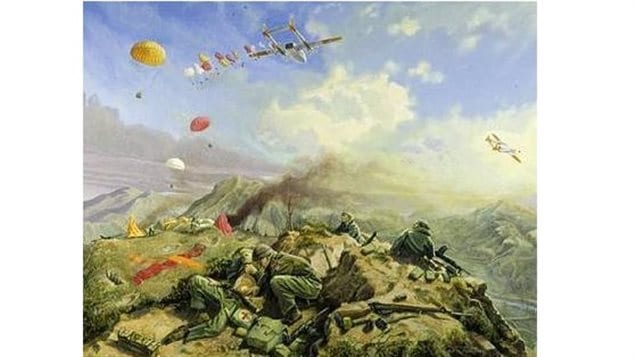
By dawn on the 25th, the Chinese withdrew, and the Canadians, still cut off, received an air drop of supplies, but the Chinese, badly mauled by their attacks on the Canadians and Australians, and an earlier attack on the British Gloucester Regt., did not return in force and the drive toward the capital was stalled.
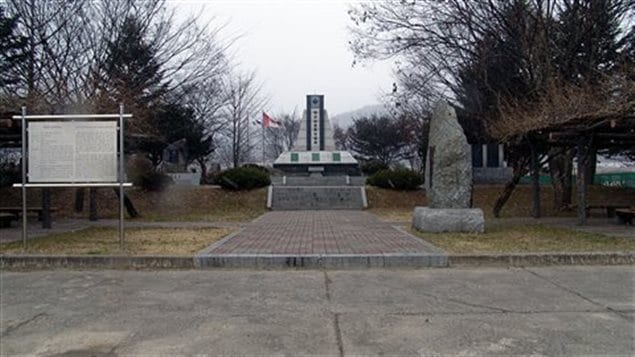
Incredibly, in spite of the ferocity of the attacks, and massive amount of bullets, grenades, mortars and shellfire, the Canadians suffered only 10 killed, and 23 wounded.
But they had stopped the Chinese. Without their courage, the Communist forces would surely have taken Seoul, and thus the country. Without the Canadians incredible determination and valour, the outcome of the war and history, may well have been entirely different.
The Chinese spring offensive ended about a week later and throughout the remainder of the war, there were no further offensives of this scale.
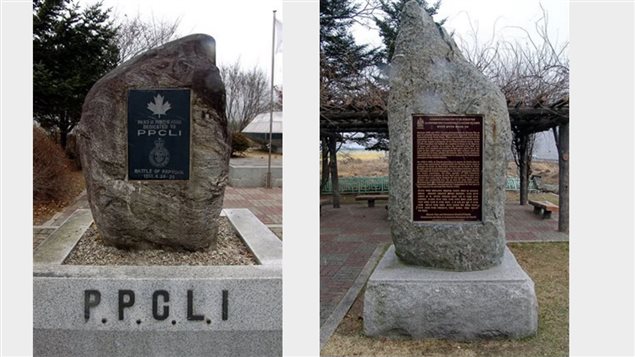
Both the Canadians and the Australians received the United States Presidential Unit Citation from the American government, the first time a Canadian unit had been so honoured.
Some 516 Canadians were killed in the Korea War.
At the ceremony in Ottawa today Minister Hehr said,’Today, we join together to keep alive the memory of those who sacrificed so much so that the next generation can support the deeply held Canadian desire to make a real and valuable contribution to a more peaceful and prosperous world.”
Additional information- sources
- Hamilton Spectator-2013- veteran remembers
- Veterans Affairs Canada- Kapyong
- Canadian Encyclopaedia- Kapyong
- Canadian Soldiers- Kapyong-
http://www.canadiansoldiers.com/history/battlehonours/korea/kapyong.htm







For reasons beyond our control, and for an undetermined period of time, our comment section is now closed. However, our social networks remain open to your contributions.